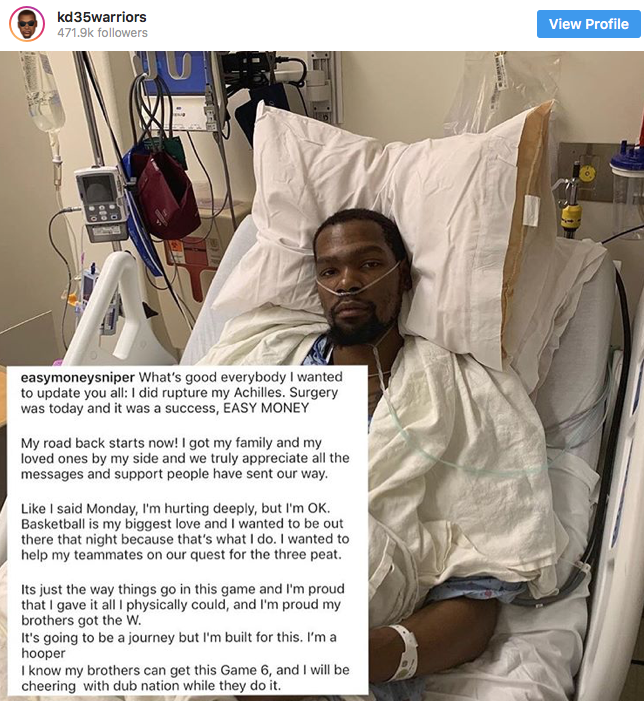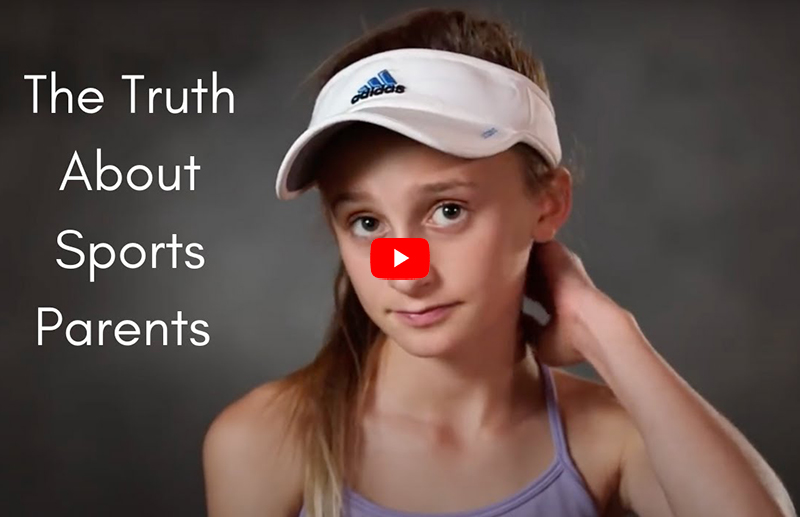
What Parents Need To Learn From Kevin Durant’s Injury
The Golden State Warriors’ Kevin Durant suffered a ruptured achilles tendon during Game 5 of the NBA Finals last season. The Warriors’ super star had been sidelined since May 8th with a strained calf. The team’s medical staff had cleared him to play and KD is a competitor and didn’t like watching his team struggle, so he came back…early. Durant will most likely miss all of next season and is facing an uphill climb with an injury that he may never completely recover from.
KD needs to be a lesson for young athletes.
Oftentimes young athletes feel the need to rush back in order to keep their spot or playing time on a highly competitive team, or as with Durant, the desire to play in a big game. It can also be parents or coaches, hurrying or pressing a child to return too early. One coach confided in me, “I’ve had parents literally text me before games and say that even if their child is saying they are still hurt, you can still play them.” I personally witnessed a 9-year-old girl crying and cradling her limp arm after a hard fall during a soccer game and the mom rushed to the sideline, yelled at the coach that she was was OK and to keep her in the game. The little girl finished out the half, but that was it. Turns out she had broken a bone in her wrist and was taken immediately to the hospital. In KD’s situation, he wanted to help his team and do his part, but he also may have been reacting to pressure from teammates and the press, there were rumors floating around that a few of the other players thought he should be playing.
USA Men’s Water Polo mental skills coach, Brian Alexander says, the biggest challenges athletes face from a psychological standpoint comes from a self-identity crisis. Without the sport, they don’t know who they are. Their confidence and their identity are too closely tied to what they do on the field, court, or in the pool. He goes on to say that when the pressure to return to play is from external sources such as coaches and teammates or in Durant’s case the opportunity to play in a once in a lifetime game situation, it can cloud their judgement. Alexander also says a big problem for highly competitive teams are the so-called ‘bubble’ athletes, who tend to hide injuries for fear of not making a roster.
What’s the parents’ role in the pressure our kids feel to be perfect?
A father of four recently lamented that his twin boys – both soccer players – returned too early from injuries and have never quite recovered. One of the twins sprained his knee after a vicious tackle during his club season and was out four weeks. After his knee recovered, he was running fine and took a light practice with no ill effects or pain. They let him play a season-ending tournament two days later. Five minutes after entering the match, he twisted his ankle so badly he had to be carried off the field. He was out three months and to this day experiences pain and swelling.
Dr. Jarrett Grunstein, a chiropractor who formerly worked with the Toronto Blue Jays, explained to the family that an injury to the knee can damage the nerves below the knee, making the ankle less stable and more prone to injury. And that injured areas NEVER fully recover and will always be more prone to re-injury, which is exactly what had happened. Neither parents nor coach fully understood the risks, and the player suffered the consequences.
His brother suffered a fractured clavicle in a high school match and required an emergency room visit and three weeks in a sling. After a 12-week recovery period and missing his entire sophomore soccer season, he was cleared to play again by an orthopedist. Another end of season tournament and he suited up with his club team for a big match against the #1 ranked team in the country in their age group. Halfway through the first period an opposing player jumped and landed on his shoulder and fractured his clavicle in exactly the same place. This twin was out another three months in recovery. The injury fully recovered and does not affect his play, but the six months and two missed seasons can’t be made up and he is now uncertain about playing soccer in college.
The soft tissue repair industry is expected to reach 17 billion dollars by 2022 with the main driver being the increasing participation of youth in sports. Dr. Tommy John, author of Minimize Injury, Maximize Performance, says, “One of the biggest mistakes in performance and healing in America today is measuring function by whether something hurts or not. Pain is the last thing to show up and the first thing to go away. Our entire sports medicine approach has turned into trying to get rid of pain in the shortest amount of time possible at the expense of long-term function. What we fail to realize is that pain is a warning letting us know that there’s damage, inflammation and swelling. What we feel IS the healing process. Pain is triggering the brain to determine what level of healing is responsible for this event. Lowering inflammation, swelling and pain as fast as possible is getting in the way of the body trying to heal itself.”
What cell phones are doing to your athlete
At the professional level this might make some sort of sense. But for youth athletes, this never makes sense. “If your son or daughter is experiencing pain from an injury we need to look at things that go well beyond pain, what caused the pain, and how this will affect their foundation for adulthood. Because the fact of the matter is the body remembers every single injury that it sustains and it has a sort of PTSD for that and it becomes the second-most common cause to all injury which is previous injury.”
As parents, what can we do? First, we need to understand that players want to play and coaches want to coach. The parent can not leave these decisions up to others, they need to advocate on behalf of their child. They need to meet with a doctor and discuss a good framework for returning to play. The injured athlete should be monitored closely and reintroduced gradually to more intense activity on a step by step basis. This will take longer than we like and require more planning and monitoring than anyone wanted or anticipated, but it’s imperative. You also may want to consider additional physical therapy or meeting with specialists like Dr. John, who focus on prevention and healing the whole body, and not just on the pain and injury at hand.
Most importantly, we must learn from KD. Don’t let your child be a hero. Rushing back from injury to play in the big game is always a mistake because it sends the wrong message and puts the player at high risk for re-injury and even permanent damage. And as parents, we need to check our own egos at the door, listen to and trust our children and make the tough choices for their overall well-being, and not just for this moment in time.











